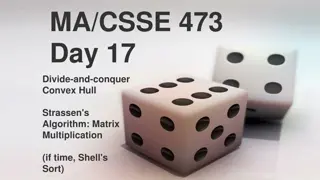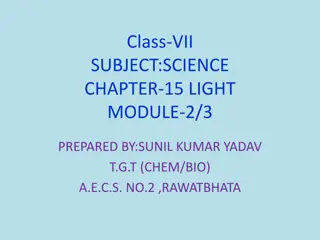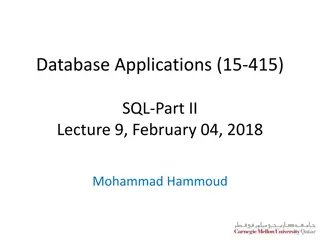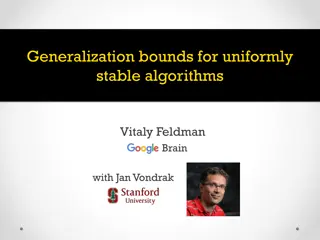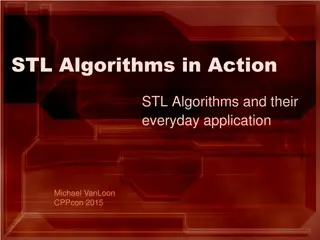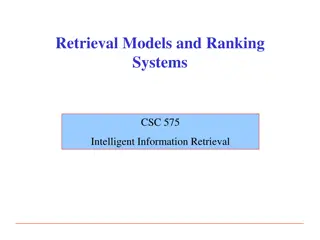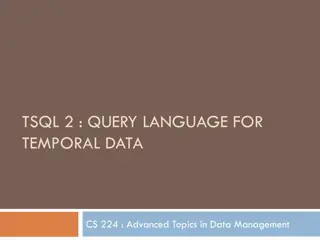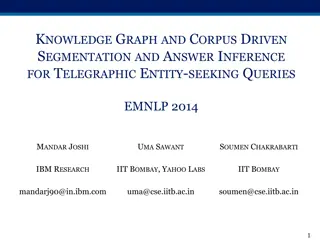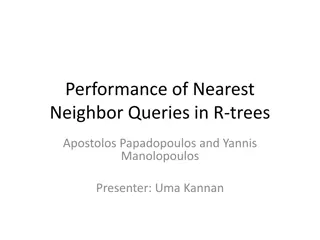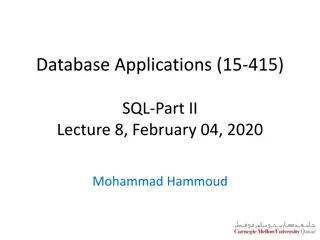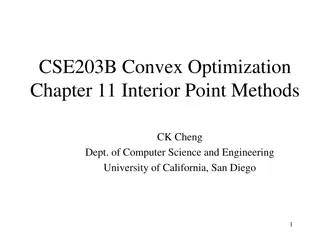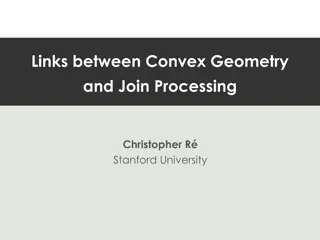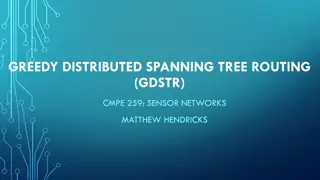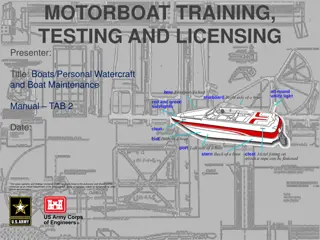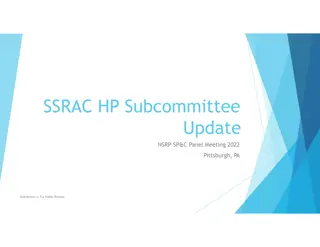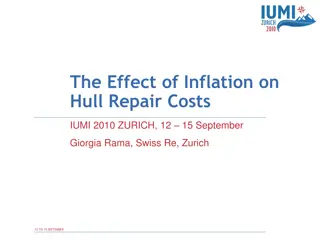Advanced Subpath Algorithms for Convex Hull Queries
This study presents innovative algorithms for subpath convex hull queries, focusing on efficient computation of convex hulls for subpaths between two vertices on a simple path in the plane. The work includes a comparison with previous methods, showcasing improvements in space complexity and query processing time. Additionally, the research discusses applications of these algorithms in various domains. It also covers topics like ray shooting among lines, intersection detection, and ray shooting among segments.
Download Presentation

Please find below an Image/Link to download the presentation.
The content on the website is provided AS IS for your information and personal use only. It may not be sold, licensed, or shared on other websites without obtaining consent from the author. Download presentation by click this link. If you encounter any issues during the download, it is possible that the publisher has removed the file from their server.
E N D
Presentation Transcript
Algorithms for Algorithms for Subpath Ray Ray- -Shooting Shooting Among Segments Among Segments Subpath Convex Hull Queries Convex Hull Queries and and Haitao Wang Utah State University SoCG 2020
Subpath Subpath convex hull queries convex hull queries Input: a simple path = p1, p2, , pnof n vertices in the plane Queries: given two vertices piand pj, compute the convex hull of the subpath (i,j) between them The convex hull should be represented in a data structure to facilitate binary-search-based queries pj p1 pn p2 pi
Previous work and our result Previous work and our result Guibas, Hershberger, and Snoeyink, 1990: O(n) space and O(log n loglog n) query time O(n loglog n) space and O(log n) query time O(n log*n) space and O(log n log* n) query time O(n) preprocessing time after sorting all vertices of by x-coordinate a compact interval tree is returned for each query support all binary-search-based queries on the convex hull in O(log n) time the convex hull can be retrieved in time linear in the number of its vertices Our result: O(n) space and O(log n) query time O(n) preprocessing time after sorting a compact interval tree is returned for each query
Applications Applications Improvements on many other problems (space reduced by a factor of log log n): Computing an optimal time-convex hull Enclosing polygons by two minimum area rectangles computing a guarding set for simple polygons in wireless location L1 top-k weighted sum aggregate nearest and farthest neighbor searching
Ray Ray- -shooting in shooting in the plane the plane Ray-shooting among lines Input: a set of n lines in the plane Queries: given a ray, find the first line hit by the ray Intersection detection Input: a set of (possibly intersecting) line segments Queries: given a line, determine whether it intersects any segment Ray-shooting among segments Input: a set of (possibly intersecting) line segments Queries: given a ray, find the first segment hit by the ray Ray-shooting among non-intersecting segments
Results: ray Results: ray- -shooting among lines shooting among lines preprocessing time n1.5 space n log2 n query time ?log? Bar-Yehuda and Fogel, 94 n1.5 log2n ?log? n log n Cheng and Janardan, 92 n0.5 + n log n n log n Agarwal and Sharir, 93 n1.5 ? log n n our result ? log n n log n n our result (holds w.h.p.)
Results: intersection detection Results: intersection detection preprocessing time n1.5 log2 n space query time ?log? n log n Cheng and Janardan, 92 n1.5 ? log n n our result ? log n n log n n our result (holds w.h.p.)
Results: ray Results: ray- -shooting among intersecting segments shooting among intersecting segments preprocessing time space n (n) log3 n n log2 n query time n0.695 log? Overmars, Schipper, and Sharir 90 2/3 + n (n) log3 n Guibas, Overmars, and Sharir 88 n (n) n n1.5 log4.33 n n (n) log4 n Agarwal, 92 ? (?) log2 n (n (n))1.5 n (n) log2 n Bar-Yehuda and Fogel, 94 ? (?) log n n1.5 log2 n n log2 n Cheng and Janardan, 92 ? log n 0.5 + n log2 n n log2 n Agarwal and Sharir, 93 n n log3 n n log2 n ? log2 n (w.h.p.) Chan, 12 n1.5 ? log n n log n our result n log2 n ? log n (w.h.p.) n log n our result
Results: ray Results: ray- -shooting among non shooting among non- -intersecting segments intersecting segments preprocessing time space query time n0.695log? n log n n Overmars, Schipper, and Sharir, 90 n1.5 log4.33 n n (n) log3 n ? log2 n Agarwal, 92 n1.5 ? log n n log n Bar-Yehuda and Fogel, 94 n1.5 ? log n n our result ? log n (w.h.p.) n log n n our result
Subpath Subpath convex hulls queries convex hulls queries Input: a simple path = p1, p2, , pn of n vertices in the plane Queries: given two vertices pi and pj, compute the convex hull of the subpath (i,j) between them Assume: all vertices of have been sorted by x-coordinate pj p1 pn p2 pi
Interval trees to store convex hulls Interval trees to store convex hulls Use an interval tree on all vertices of to store the convex hull of upper hull and lower hull are stored separately Each hull edge is stored at the highest node spanned by it Issue: many empty nodes
Change the interval tree to a Change the interval tree to a c compact Remove empty nodes by relinking each non-empty node the child of its nearest non-empty ancestor Size of the CIT is the linear in the number of hull edges ompact i interval nterval t tree ( ree (CIT CIT) )
Two lemmas Two lemmas T( ): the CIT of any subpath of Lemma 1 (GHS 90 ): With O(n) time preprocessing, T( ) for any subpath of can be computed in O(| |) time. Lemma 2 (GHS 90 ): Given T( 1) and T( 2) for two consecutive subpaths 1and 2, T( 1 2) can be computed in O(log n) time and O(log n) additional space by merging T( 1) and T( 2), without altering T( 1) or T( 2).
Preprocessing Preprocessing Build a decomposition tree DT( ) A complete binary tree whose leaves correspond to the vertices of following their order in Remove those nodes whose subtrees have less than log2 n leaves Each leaf in the new tree DT( ) corresponds to a canonical subpath of log2 n vertices Each internal node v corresponds to a canonical subpath DT( ) has O(n / log2 n) nodes Build a CIT for the canonical subpath of each leaf by Lemma 1 O(log2 n) time for each leaf O(n) time for all leaves In a bottom-up manner, build a CIT for the canonical subpath of each internal node, by merging the CITs at their children, by Lemma 2 O(log n) time for each node O(n) time for all O(n / log2 n) nodes Total preprocessing time/space: O(n) a subpath of log2 n vertices
A preliminary query algorithm of O(log A preliminary query algorithm of O(log2 2 n) time n) time Consider two query vertices pi and pj of If pi and pj are from the same leaf, the query subpath (i,j) has at most log2 n vertices compute T( (i,j)) directly by Lemma 1, in O(log2 n) time i j
If pi and pj are not from the same leaf, v: the leaf containing pi u: the leaf containing pj w: the lowest common ancestor of u and v partition (i,j) into two subpaths one is contained in the left subtree of w one is contained in the right subtree of w compute the CITs for the two subpaths separately and then merge them by Lemma 2 in O(log n) time Compute the CIT for left subpath (i,k) partition it into two subpaths one contained in v compute its CIT directly by Lemma 1 O(log2 n) time the other covered by the blue subtrees merge the CITs for O(log n) canonical subpaths by Lemma 2 O(log2 n) time compute the CITs for the two subpaths separately and then merge them by Lemma 2 in O(log n) time w v u i t j (i,j) k
Improve the query time to O(log n) Improve the query time to O(log n) If pi and pj are from the same leaf, the query subpath (i,j) has at most log2 n vertices compute T( (i,j)) directly by Lemma 1, in O(log2 n) time Improvement: For the canonical subpath v at each leaf v, build its decomposition tree DT( v) in the same way as DT( ) If pi and pj are from the same leaf v, use DT( v) to answer the query Query time: O(log2 log n) Total preprocessing: O(n) v i j
pi and pj are not from the same leaf (i,t): subpath covered by v (t+1,k): subpath covered by the blue subtrees Improvement for computing T( (i,t)): Observation: (i,t) is a suffix subpath of the subpath v stored at v More preprocessing on v: Partition v into O(log n) sub-subpaths of size log n For each sub-subpath, compute its CIT directly by Lemma 1 in O(log n) time For each sub-subpath , compute the CIT for the suffix subpath of v beginning with , by Lemma 2 Total preprocessing: O(log2 n) by Lemma 2 Query algorithm: Find the sub-subpath containing i Partition (i,t) into two subpaths One contained in the other is a suffix subpath of v w v u i k t j (i,j) v (i,t) i compute its CIT directly by Lemma 1 in O(log n) time its CIT is available in the preprocessing
pi and pj are not from the same leaf (i,t): subpath covered by v (t+1,k): subpath covered by the blue subtrees Improvement for computing T( (t+1,k)): It corresponds to an ancestor-leaf pair (w,v) Precompute the CITs for all these pairs in the decomposition tree DT( ) by Lemma 2 There are O(n/log n) such pairs because DT( ) has O(n/log2 n) leaves Total preprocessing: O(n) T( (t+1,k)) is available during the query w v u i k t j Thank you for your attention! Thank you for your attention!






